Bill Gates and Carlos Slim Partner to Support Innovation for Farmers
Daimoniz Miondo is one of 800 farmers in Chipeni, Mvera Extension Planning Area, Dowa District, Malawi, who has adopted conservation agriculture practices in recent years with joint support from Malawi’s Department of Agricultural Extension Services, the NGO Total LandCare, and CIMMYT. “I’m harvesting between 30 and 40 bags of maize now per acre, where I used to get only 15 or 20 bags,” says Miondo, who farms to support a household of seven. “Before conservation agriculture, there was a lot of erosion and the rain would wash away the fertilizer and affect the yields.” Conservation agriculture practices cut labor and other farm costs, as well as helping to capture and hold rainfall, thus salvaging harvests when drought hits. Photo credit: Trevor Samson/CIMMYT
Originally posted on the Impatient Optimists blog (Bill & Melinda Gates Foundation) on 13 February 2013.
We are extremely pleased to welcome Bill Gates and Carlos Slim Helú to CIMMYT headquarters near Mexico City today. They have come to inaugurate major infrastructure improvements for CIMMYT supported by their respective foundations. The nearly 20,000 square meters of construction include badly-needed advanced laboratories, greenhouses, and training facilities. They will be used for cutting-edge research by CIMMYT to help speed the access of developing country farmers to the benefits of science and innovation.
Where are we now and what have we learned?
The repeated food price hikes of recent years most sorely affect the poor, who spend as much as three-quarters of their daily income simply to eat. We know that 0.8 billion human beings are not eating enough.
We’ve not seen the last of food price crises. Widespread, severe droughts of 2012 have devastated global grain harvests, further reduced food stocks, made export markets skittish. Because the world relies heavily on a few, high-production “bread basket” countries, low stocks superimposed on financial speculation will surely bring further, seismic shocks to global food markets.
From the 2007-08 food price peaks, which fueled food riots in more than 30 countries, it should be clear that global food security is everyone’s concern, in both developed and developing countries.
Not all is gloom and doom: Innovation can support more precise and productive science and farming.
There is hope, and more bountiful harvests and sustainable agriculture are key parts of the solution. In many developing countries farming continues to employ large segments of the populace and plays a central role in national economies. There is enormous potential for farmers to boost productivity, reduce reliance on destructive practices, move beyond subsistence, and power development at large. Best of all, new, exciting science is available to adapt to small-scale farmers’ needs, and these farmers are actually looking to policymakers and research and extension organizations to support them.
CIMMYT partners with those actors and others worldwide to offer farmers improved options: better seed and knowhow, improved cropping systems, more secure crop storage methods. Progressive farmers begin to view their daily occupation as an enterprise, rather than mere subsistence, so the focus shifts onto science and innovation to gain precision. Several examples:
- DNA analysis to home in on high-value maize and wheat traits for better yields, disease resistance, heat and drought tolerance.
- Doubled haploids to speed the creation of genetically pure inbred lines and new maize hybrids.
- Conservation and precision agriculture, including more targeted application of irrigation water and fertilizer to boost system output while saving resources and the environment.
- Cell phone services so farmers can access precise, locally-tailored information on weather, markets, recommended crops and practices for their fields.
An extraordinary initiative funded by and co-coordinated with Mexico—known as MasAgro, the Sustainable Modernization of Traditional Agriculture—is taking these and other innovations directly to Mexican farmers and sequencing the DNA of CIMMYT’s vast maize and wheat seed collections. Similarly innovative partnerships in Africa and Asia feature cropping systems approaches to increase yields and the resilience of the resource base, while supporting farmers’ direct involvement to test and promote new practices. Millions of smallholder farmers and consumers in sub-Saharan Africa are benefiting from the adoption of drought tolerant maize varieties developed using advanced breeding techniques.
The work of all these partners, including CIMMYT, would not be possible without the support of other key partners: national governments, foundations, development banks, and other public and private agencies, including the CGIAR Consortium, who represent the political will and commitment of their constituents through their donations and engagement. The Bill & Melinda Gates Foundation provides not only momentous funding for our work, but invaluable technical guidance and political support.
Returning to today’s inauguration, thanks to the generous support of the Carlos Slim Foundation and the Bill & Melinda Gates Foundation, we have effectively doubled our research capacity here in Mexico.
We can accelerate our efforts to unlock the tremendous potential of wheat and maize using modern information and communications technology, combined with the improved and more sustainable agricultural practices. The very personal and proactive engagement in CIMMYT’s mission of visionary personalities such as Mr. Slim Helú and Mr. Gates, and the on-going support of their respective foundations for our relatively little-known research institute, send a strong signal to the world that something important must be going on here. Indeed there is.
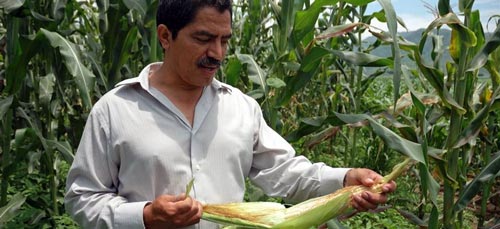
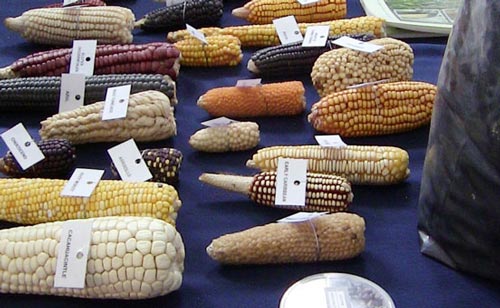 National Service Seed Inspection and Certification (
National Service Seed Inspection and Certification (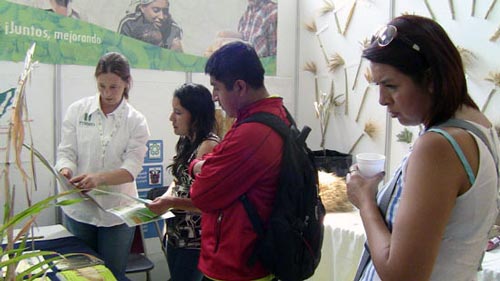 CIMMYT participated in the fair through its Seeds of Discovery (SeeD) initiative under the Genetic Resources Program. Martha Willcox (SeeD maize phenotyping coordinator) and Carolina Saint Pierre (SeeD wheat phenotyping coordinator) presented maize and wheat collections from the CIMMYT genebank and a poster prepared by Paulina González and Bibiana Espinosa from the germplasm bank emphasizing the importance of seed conservation and its long-term benefits for humanity. CIMMYT team was also represented by Isabel Peña, Institutional Relations Head, who provided visitors with information on CIMMYT. The CIMMYT booth was visited by many students, professors, and farmers. The students and professors expressed a particular interest in CIMMYT’s publications on maize and wheat diseases, conservation agriculture, the SeeD initiative, breeding for drought and low nitrogen tolerance, breeding of native maize (criollos), and grain storage techniques. Farmers were mostly interested in CIMMYT maize collections samples. They also shared their experience working with different types of maize.
CIMMYT participated in the fair through its Seeds of Discovery (SeeD) initiative under the Genetic Resources Program. Martha Willcox (SeeD maize phenotyping coordinator) and Carolina Saint Pierre (SeeD wheat phenotyping coordinator) presented maize and wheat collections from the CIMMYT genebank and a poster prepared by Paulina González and Bibiana Espinosa from the germplasm bank emphasizing the importance of seed conservation and its long-term benefits for humanity. CIMMYT team was also represented by Isabel Peña, Institutional Relations Head, who provided visitors with information on CIMMYT. The CIMMYT booth was visited by many students, professors, and farmers. The students and professors expressed a particular interest in CIMMYT’s publications on maize and wheat diseases, conservation agriculture, the SeeD initiative, breeding for drought and low nitrogen tolerance, breeding of native maize (criollos), and grain storage techniques. Farmers were mostly interested in CIMMYT maize collections samples. They also shared their experience working with different types of maize.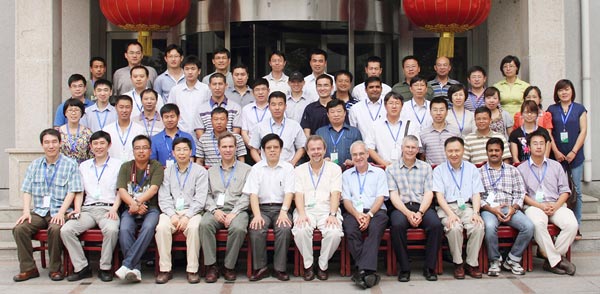
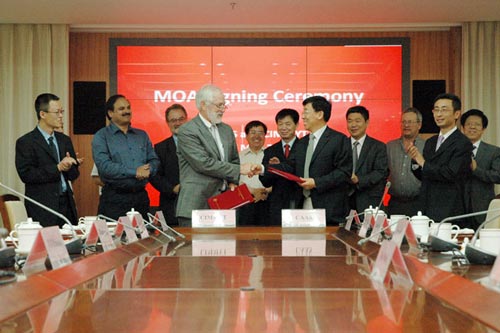 As indicated in Ren Wang’s speech, CIMMYT has the largest investment in China among CGIAR centers. Five collaborative research programs led by CIMMYT scientists stationed in China have been established at CAAS, Yunnan and Sichuan. This has created a new model for CGIAR-China collaboration and increased CIMMYT’s impact in China. CIMMYT is also the first international center to establish collaborative projects with the National Natural Science Foundation of China.
As indicated in Ren Wang’s speech, CIMMYT has the largest investment in China among CGIAR centers. Five collaborative research programs led by CIMMYT scientists stationed in China have been established at CAAS, Yunnan and Sichuan. This has created a new model for CGIAR-China collaboration and increased CIMMYT’s impact in China. CIMMYT is also the first international center to establish collaborative projects with the National Natural Science Foundation of China.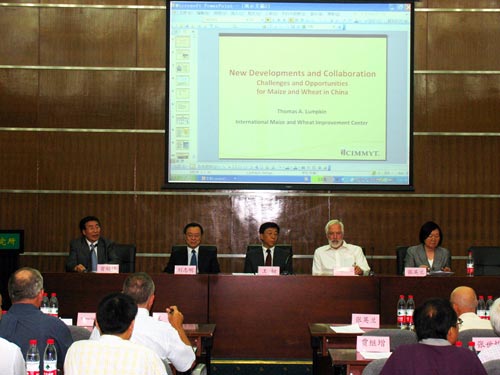 Bed planting has produced significant impact in the provinces of Gansu, Ningxia, Sichuan, Shandong, and Henan, bringing among other benefits a 30% reduction in input use. Bed planting is particularly advantageous at saving water. Conservation agriculture techniques combined with new winter wheat varieties have been broadly extended in traditional spring wheat areas, allowing farmers to take advantage of climate change to increase yields and reduce input use.
Bed planting has produced significant impact in the provinces of Gansu, Ningxia, Sichuan, Shandong, and Henan, bringing among other benefits a 30% reduction in input use. Bed planting is particularly advantageous at saving water. Conservation agriculture techniques combined with new winter wheat varieties have been broadly extended in traditional spring wheat areas, allowing farmers to take advantage of climate change to increase yields and reduce input use.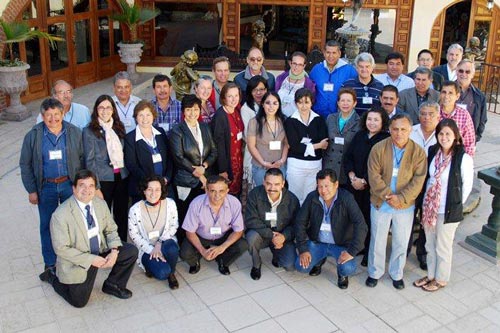 In order to define the research priorities for the Seeds of Discovery initiative in maize quality of landraces (a Strategic Initiative of both CRPs MAIZE and WHEAT funded by Mexico), a diverse group of food scientists, chemists, maize breeders, genebank curators, social scientists, and representatives of research institutions such as UNAM and Chapingo, met for a workshop to discuss future research on quality characteristics within native Mexican maize.
In order to define the research priorities for the Seeds of Discovery initiative in maize quality of landraces (a Strategic Initiative of both CRPs MAIZE and WHEAT funded by Mexico), a diverse group of food scientists, chemists, maize breeders, genebank curators, social scientists, and representatives of research institutions such as UNAM and Chapingo, met for a workshop to discuss future research on quality characteristics within native Mexican maize.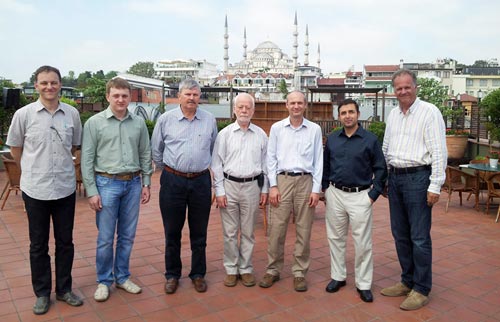 GRIS (
GRIS (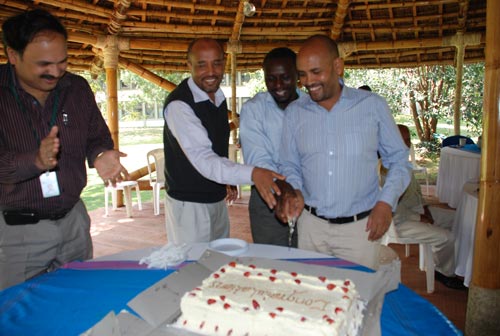 To share the good news, the Socioeconomics program hosted a get-together with the team in Nairobi, Kenya. During the cake cutting ceremony, the best gender paper award was dedicated to women farmers from Embu and Kakamega in Kenya’s Eastern and Western Provinces, where the data was collected. The Nairobi team also took the opportunity to initiate monthly seminars in order to share research findings hosted by the Global Maize Program and the Socioeconomics program and promote regular interaction among the team. The program directors, Bekele Shiferaw and B. M. Prasanna nominated Dan Makumbi, Hugo De Groote, Sika Gbegbelegbe, Fred Kanampiu, and Sarah Kibera, to form the organizing committee for the seminars.
To share the good news, the Socioeconomics program hosted a get-together with the team in Nairobi, Kenya. During the cake cutting ceremony, the best gender paper award was dedicated to women farmers from Embu and Kakamega in Kenya’s Eastern and Western Provinces, where the data was collected. The Nairobi team also took the opportunity to initiate monthly seminars in order to share research findings hosted by the Global Maize Program and the Socioeconomics program and promote regular interaction among the team. The program directors, Bekele Shiferaw and B. M. Prasanna nominated Dan Makumbi, Hugo De Groote, Sika Gbegbelegbe, Fred Kanampiu, and Sarah Kibera, to form the organizing committee for the seminars.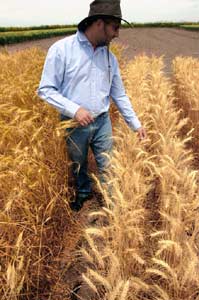 Centuries ago, Spanish monks brought wheat to Mexico to use in Roman Catholic religious ceremonies. The genetic heritage of some of these “sacramental wheats” lives on in farmers’ fields. CIMMYT researchers have led the way in collecting and characterizing these first wheats, preserving their biodiversity and using them as sources of traits like disease resistance and drought tolerance.
Centuries ago, Spanish monks brought wheat to Mexico to use in Roman Catholic religious ceremonies. The genetic heritage of some of these “sacramental wheats” lives on in farmers’ fields. CIMMYT researchers have led the way in collecting and characterizing these first wheats, preserving their biodiversity and using them as sources of traits like disease resistance and drought tolerance.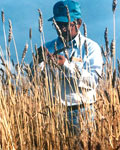
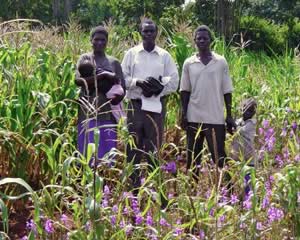 Looks can deceive. Striga, a deadly parasitic plant, produces a lovely flower but sucks the life and yields out of crops across Africa and Asia. A new strain of improved maize seed is helping farmers reclaim their invaded crop lands.
Looks can deceive. Striga, a deadly parasitic plant, produces a lovely flower but sucks the life and yields out of crops across Africa and Asia. A new strain of improved maize seed is helping farmers reclaim their invaded crop lands.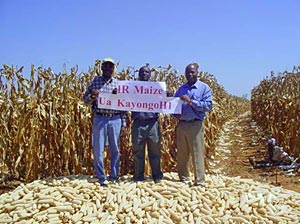
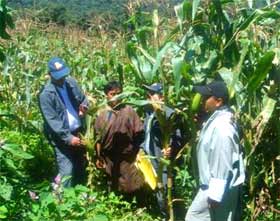 Sandwiched between China and India, the Kingdom of Bhutan is a small country that relies on maize in a big way. But maize yields are typically low due to crop diseases, drought, and poor access to seed of improved varieties, among other reasons. CIMMYT is committed to improving Bhutan’s food security by providing high-yielding, pest-resistant maize varieties to farmers and capacity-building for local scientists.
Sandwiched between China and India, the Kingdom of Bhutan is a small country that relies on maize in a big way. But maize yields are typically low due to crop diseases, drought, and poor access to seed of improved varieties, among other reasons. CIMMYT is committed to improving Bhutan’s food security by providing high-yielding, pest-resistant maize varieties to farmers and capacity-building for local scientists.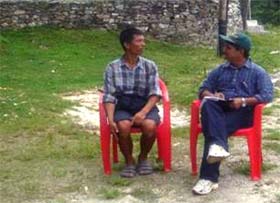
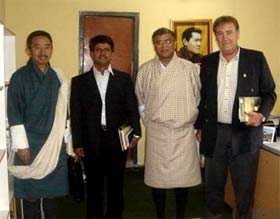 “Our CIMMYT office in Nepal has assisted Bhutan with maize and wheat genetic material, technical backstopping, training, visiting scientist exchange, and in identifying key consultants on research topics such as grey leaf spot and seed production,” says Tiwari.
“Our CIMMYT office in Nepal has assisted Bhutan with maize and wheat genetic material, technical backstopping, training, visiting scientist exchange, and in identifying key consultants on research topics such as grey leaf spot and seed production,” says Tiwari.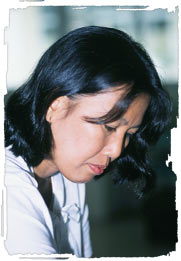 Young Indonesian researchers are reaping the benefits of collaboration with CIMMYT and at the same time helping farmers in their country.
Young Indonesian researchers are reaping the benefits of collaboration with CIMMYT and at the same time helping farmers in their country.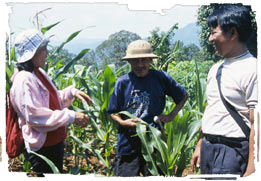 “This is the untold story of the quiet biotech revolution going on in maize breeding in Asia,” says CIMMYT’s Luz George. “It is a successful transfer of technology from CIMMYT to developing countries which has now found direct application in the work of national program maize breeders.”
“This is the untold story of the quiet biotech revolution going on in maize breeding in Asia,” says CIMMYT’s Luz George. “It is a successful transfer of technology from CIMMYT to developing countries which has now found direct application in the work of national program maize breeders.”